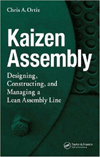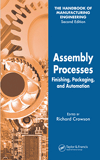In their competition for market share, car companies are trying to attract customers by offering an ever-broader range of options and special-order features. This means that today’s new-car buyer not only has a cornucopia of features to choose from, but also that the menu of features itself changes frequently.
Consequently, suppliers have to cope with an ever-growing number of variations in the components and subassemblies they manufacture. At the same time, automakers are demanding faster response to changes. As a result, suppliers must react flexibly to complex and rapidly changing requirements.
Flexibility with respect to both production volume and delivery time are also very significant issues for suppliers. For a certain period after a new car model goes into production the automaker often needs comparatively small amounts of the new components and subassemblies. Then as sales volume and production increase, the automaker may need more than 10 Arial as many parts as were needed during initial model launch, and may need them delivered more than 10 Arial sooner.
Dedicated high-volume assembly systems work well in situations where the demand for high-volume production continues long enough to amortize the capital equipment cost. But because of increasingly shorter product life cycles, demand often falls drastically after only a few years—or less—of relatively high sales. Production doesn’t stop, however, because the automaker still has to supply replacement parts. These parts, which the automaker may have to have available for 12 or more years, will be ordered in very small batches. In such situations, flexible assembly systems can be an attractive alternative to dedicated assembly lines.
Production Delays Are Time-Critical
Leopold Kostal GmbH & Co. KG (L?denscheid, Germany) develops and manufactures high-end electronic and electromechanical components for major car manufacturers worldwide. Much of the capital equipment Kostal uses for assembling these components is highly sophisticated and reflects crucial areas of the company’s production know-how. The company builds most of this equipment itself because it regards this expertise as one of its core competencies.A company that loses the time-to-market race loses reputation and market share. As its customers increasingly strive to shorten time-to-market, the time Kostal needs to design and build assembly equipment becomes crucial. On one hand, the designers have to wait until the product has reached a level of maturity that excludes major design changes. On the other hand, because new models have to be on the market within the shortest possible time period, this "wait for design maturity" approach virtually guarantees very tight time schedules for building assembly equipment.
Traditionally, the time needed to construct a moderately complex production line for assembling items such as the switch for an electric car window could range from 6 to 8 months. As its customers have increasingly pressed for a significant reduction in this time, Kostal decided to introduce flexible production structures. Kostal opted for the Teamos assembly system, from teamtechnik Maschinen und Anlagenbau GmbH (Freiberg, Germany, and Atlanta).
Plug-and-Produce
The Teamos system designers adapted the plug-and-play concept of computer systems to industrial production technology. The bare units and process modules of the Teamos system are analogous to the computer motherboard. They can be freely sequenced and jointly served by a configurable transfer belt system. A base unit can either be an automated or a manual workstation. An automated base unit can host as many as four, 400-millimeter wide process modules. Each process module is an assembly station that can be fitted with individual, customer-specific equipment by teamtechnik or the customer. Workpieces are transported on individual carriers.Base units as well as process modules can be added or removed—the plug function—with a manual forklift. Self-centering conical locating pins ensure that adjacent process modules are aligned correctly. Standardized multipurpose connectors provide electrical power, data links and pressurized air. Thus, a process module can be exchanged in a few minutes. Workpiece carriers are transported between individual process modules by the standardized TS2 transfer system from Bosch.
Kostal purchases only base units and untooled process modules, and does most of the process-specific engineering itself. In some cases, an external specialist may equip a particular process module with a specific assembly technology. This philosophy makes it easy for Kostal engineers to concentrate on the best use of their core competencies. In addition, if an external solution provider is involved, Kostal engineers can simply pass on the interface specifications defined by teamtechnik.
Production Ready in 4 Months
Kostal selected its first Teamos system in 1999 to assemble two variants of a command switch for electric car windows. This project also had the specific objective of assessing the Teamos system’s potential to reduce development time.Although the project did not actually start until January 2000, the line, designed for an annual capacity of 600,000 switches, became ready for secure production at the end of April. Only 3 months later, production capacity was doubled to 1.2 million switches per year. Traditionally, 6 to 8 months had been considered normal for bringing such a line into production. Achieving production readiness in less than 4 months demonstrated the potential for reducing development time.
Another important advantage Kostal sees with this system is its high flexibility for combining automated and manual stations. This was illustrated by a second project: a line for producing a multifunction steering column command lever. This complex part is produced in four different types with two additional subvariants. In this project, the ability of the system to accommodate large changes in production volume was crucial. When production started up in the summer of 2001 the customer needed only 200,000 parts per year. At that time, the line comprised three process modules in one base unit, complemented by two manual workstations.
By the end of this year, production capacity will have to jump to 1.2 million units. The Kostal designers already know they will be able to achieve this increase by replacing manual operations with three additional automated process modules. And sometime in the future, when the customer needs fewer parts, capacity can be reduced by exchanging modules.
When tackling future projects, Kostal designers intend to focus on maximum application versatility of individual process modules. Their goal will be to make them reusable for other production processes. If it becomes possible to design reconfigurable process platforms for comparable tasks, such as driving screws, the setup time for assembly lines can be further reduced. In addition, the number of modules kept in stock to produce spare parts for older products could be reduced substantially.
For more information about Teamos systems, call teamtechnik Corp. (Atlanta) at 770-938-2003 or visit www.teamtechnik.com.





